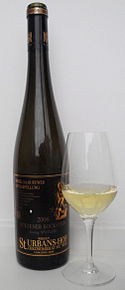Predicate late harvest
Spätlese is a predicate for quality wines . It belongs to the wine quality level of the predicate wines . In German-speaking countries, the predicate is used today for wines with a certain minimum must weight (measured in degrees Oechsle ). The specified minimum must weight for a late harvest varies in Germany from growing area to growing area and sometimes even within a growing area from grape variety to grape variety. The late harvest category is above Kabinett and below Auslese .
history
A story told frequently and in different variations says that the name originated in the Rheingau around 1775 . At that time, the wineries there were required to be allowed to read by the communities. An exception, however, was the Johannisberg Castle Estate , which belonged to the Fulda diocese . The Johannisberg monks had to obtain permission for the grape harvest directly from the Fulda prince-bishop . They therefore sent a mounted messenger to Fulda in 1775, but in that year the return of the messenger was delayed for unknown reasons (three different reasons are given depending on the narrative). The grapes had meanwhile been attacked by gray mold rot ( Botrytis cinerea ). Although they thought the harvest had been lost, the monks brought in the grapes and pressed them. When they tasted the young wine the following spring, they were surprised by its excellent quality. The term Spätlese then became common for particularly high-quality wines , and the positive effects of noble rot , the infestation by this mold , were discovered.
In fact, the story is more complex, because as early as 1733 it is documented for Schlossgut Johannisberg that the grape harvest was delayed in order to achieve a better quality result due to noble rot. For 1730, further documents show that this procedure was used in different areas of Germany. Such a procedure can be proven for Mainz for 1726. The Schlossgut Johannisberg, however, deserves the credit of having systematically expanded this process and making it known as "Auslese" (with additional additions such as "Fine Auslese", "Hochfeine Auslese" etc.). The term “late harvest” was only officially introduced in 1909.
The first volume "Karl the Spätlesereiter" of the Karl comic series deals with the legend of 1775.
Manufacturing and quality standards
Since 1971 have in Germany quality wines with predicate Spätlese following legally established manufacturing and quality standards meet: You must be logged in to read check, the grapes are allowed only after the general reader , the late harvest date on which by the autumn committee of the community is set to be read and the grapes must exceed a minimum must weight value: in general, this is 85 ° Oechsle, in the Baden wine-growing region, depending on the grape variety, 86 ° to 95 ° Oechsle. Enriching the musts by adding sugar is not permitted. According to the German wine law, fortification is fundamentally forbidden in all quality wines with a predicate, including the late harvest. Unlike in Germany, in France it is permissible to add sugar to the unfermented must up to the highest quality levels.
Since it is in a cool climate, e.g. May as at the Moselle happen that the musts not completely thorough fermentation and stop, there are also traditionally rest sweet late harvest. For many decades, the term Spätlese stood primarily for those naturally sweet wines that can also be produced by interrupting fermentation by means of cooling or filtering. Many wine drinkers have come to believe that Spätlesen are always sweet wines. However, in recent years more and more Spätlese wines have been made dry , so that a large part of the sugar is fermented. These are usually marked with the addition "dry" on the label. If this information is missing, it can be assumed that the wine has a higher residual sweetness.
In Austria Spätlese belongs to the predicate wines . The grapes must be fully ripe and at least 94 ° Oechsle (19 ° KMW ), the must must not be enriched and must come from grape varieties that are shown in the quality register of grape varieties. Like all predicate wines, the late harvest must have an official test number.
See also
literature
- Cornelius Lange, Fabian Lange : The Wine Lexicon. Completely revised and supplemented new edition. Fischer-Taschenbuch-Fischer, Frankfurt am Main 2003, ISBN 3-596-15867-2 .
Web links
- Weindorf Johannisberg: The discovery of the late harvest
- Service Center Rural Area Rheinhessen-Nahe-Hunsrück: Influence of the reading date on the wine quality PDF file 50 kB
Individual evidence
- ↑ The discovery of the late harvest on weindorf-johannisberg.de . Retrieved November 14, 2019.
- ↑ The late harvest ... a lazy magic on caesar-michel.de , accessed on November 14, 2019.

